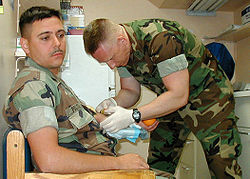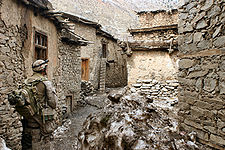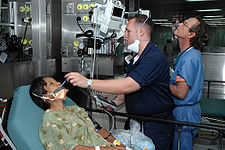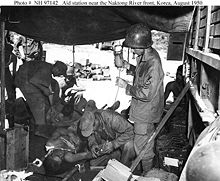- United States Navy Hospital Corpsman
-
Hospital Corpsman 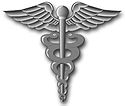
Rating insigniaIssued by: United States Navy Type Enlisted rating Abbreviation HM Specialty Medical A Hospital Corpsman (HM) (pronounced /ˈkɔərmən/) is an enlisted medical specialist for the United States Navy who serves with Navy and United States Marine Corps units. The Hospital Corpsman works in a wide variety of capacities and locations, including shore establishments such as naval hospitals and clinics, aboard ships, and as well as the primary medical caregivers for sailors while underway. Hospital Corpsmen are frequently the only medical care-giver available in many fleet or Marine units on extended deployment. In addition, Hospital Corpsman perform duties as assistants in the prevention and treatment of disease and injury and assist health care professionals in providing medical care to Navy people and their families. They may function as clinical or specialty technicians, medical administrative personnel and health care providers at medical treatment facilities. They also serve as battlefield corpsmen with the Marine Corps, rendering emergency medical treatment to include initial treatment in a combat environment. Qualified hospital corpsmen may be assigned the responsibility of independent duty aboard ships and submarines; Fleet Marine Force, SEAL and Seabee units, and at isolated duty stations where no medical officer is available.
Corpsmen were trained at Naval Hospital Corps School, Great Lakes, Illinois until the 2005 Base Realignment and Closure, when Corps School were scheduled to relocate to the Medical Education and Training Campus at Joint Base San Antonio, Texas.[1] As of mid-2011 Naval Hospital Corps School, Great Lakes, Illinois has been officially closed and operations moved to San Antonio, Texas.
The colloquial form of address for a Hospital Corpsman is "Doc." In the U.S. Marine Corps, this term is generally used as a sign of respect.[citation needed]
History
Prior to the establishment of the Hospital Corps, enlisted medical support in the Navy was limited in scope. In the Continental Navy and the early U.S. Navy, medical assistants were assigned at random out of the ship's company. Their primary duties were to keep the irons hot and buckets of sand at the ready for the operating area. It was commonplace during battle for the surgeons to conduct amputations and irons were used to close lacerations and wounds. Sand was used to keep the surgeon from slipping on the bloody ship deck. Previously, Corpsman were commonly referred to as a Loblolly boy, a term borrowed from the British Royal Navy, and a reference to the daily ration of porridge fed to the sick. The nickname was in common use for so many years that it was finally officially recognized by the Navy Regulations of 1814. In coming decades, the title of the enlisted medical assistant would change several times—from Loblolly Boy, to Nurse (1861), and finally to Bayman (1876). A senior enlisted medical rate, Surgeon's Steward, was introduced in 1841 and remained through the Civil War. Following the war, the title Surgeon's Steward was abolished in favor of Apothecary, a position requiring completion of a course in pharmacy.
Still, there existed pressure to reform the enlisted component of the Navy's medical department—medicine as a science was advancing rapidly, foreign navies had begun training medically skilled sailors, and even the U.S. Army had established an enlisted Hospital Corps in 1887. Navy Surgeon General J.R Tyron and subordinate physicians lobbied the Navy administration to take action. With the Spanish-American War looming, Congress passed a bill authorizing establishment of the U.S. Navy Hospital Corps, signed into law by President William McKinley on 17 June 1898. Three rates were created therein—Hospital Apprentice, Hospital Apprentice First Class (a petty officer third class), and Hospital Steward, which was a chief petty officer.
A revision in 1916 established a new rate structure. With the introduction of a second junior rate there were now Hospital Apprentice Second Class (HA2c) and Hospital Apprentice First Class (HA1c). The rating title for petty officers was established as Pharmacist's Mate (PhM), following the pattern of some of the Navy's other ratings (boatswain's mate, gunner's mate, etc.). Pharmacist's Mate Third Class (PhM3c), Second Class (PhM2c), and First Class (PhM1c) were now the petty officers, and Chief Pharmacist's Mate (CPhM) was the CPO. This structure that would remain in place until 1947.
During World War I, hospital corpsmen served throughout the fleet, earning particular distinction on the Western Front with the Marine Corps. A total of 684 personal awards were awarded to hospital corpsmen in the war, including 2 Medals of Honor, 55 Navy Crosses, and 237 Silver Stars.
In World War II, hospital corpsmen hit the beach with Marines in every battle in the Pacific. Joe Rosenthal's iconic photo of the flag-raising on Iwo Jima, captured during that battle's early days, depicts Pharmacist's Mate Second Class John Bradley among the group of Marines on Mt. Suribachi that day. They also served on thousands of ships and submarines. Notably, three unassisted emergency appendectomies were performed by hospital corpsmen serving undersea and beyond hope of medical evacuation. The Hospital Corps has the distinction of being the only corps in the U.S. Navy to be singled out in a famous speech by Secretary of the Navy James Forrestal after the conclusion of the war.[2] Following the war, the Hospital Corps changed its rating title to the generic term it had used all along—Hospital Corpsman. The rates of hospital corpsman third class (HM3), second class (HM2), and first class (HM1), and chief hospital corpsman (HMC) were supplemented by senior chief hospital corpsman (HMCS) and master chief hospital corpsman (HMCM) in 1958.
Hospital corpsmen continued to serve at sea and ashore, and accompanied Marine units into battle during the Korean and Vietnam wars. Fifteen hospital corpsmen were counted among the dead following the bombing of the Marine barracks in Beirut in 1983. Today, hospital corpsmen are serving in the Iraq and Afghanistan wars providing corpsmen for convoys, patrols, and hospital or clinic treatment.
Prior to selection to the Command Master Chief program, the 11th MCPON, Joe R. Campa, was a Hospital Corpsman.
Training
Training to become an HM-8404 Hospital Corpsman (Field medical service technician) begins at Camp Lejeune, Jacksonville, North Carolina, or at Camp Pendleton, California, also known as FMTB - Field Medical Training Battalion. Each student is issued a MARPAT camouflage uniform to be worn throughout their training. Training is almost as vigorous and rough as basic training for the United States Marine Corps. Students must be physically fit, and are required to practice giving IV's and other forms of medication to each other in the field. They train daily in all weather conditions, and must learn how to disassemble, clean, and reassemble their rifles. Any sailor not meeting the requirements to pass will be dropped from the program.
Organization
Because of the need for Hospital Corpsmen in a vast array of foreign, domestic, and shipboard duty stations, as well as with United States Marine Corps units, the Hospital Corps is the largest rating in the United States Navy.
The basic training for Hospital Corpsmen is Naval Hospital Corps School, located in Great Lakes, IL, one of the Navy's "A" schools (primary rating training). Upon graduation, the Hospital Corpsman is given the Navy Enlisted Classification (NEC) code of HM-0000, or "quad-zero" in common usage. NECs are analogous to MOS in the United States Army and Marine Corps, or AFSC in the Air Force. There are primary NECs, and secondary NECs. For example, a Hospital Corpsman who completes Field Medical Service School (FMSS) and earns the NEC HM-8404, moves that NEC to primary and has a secondary NEC of HM-0000. If that Hospital Corpsman attends a "C" School, then the NEC earned at the "C" School becomes their primary and HM-8404 becomes the secondary. Some Hospital Corpsmen go on to receive more specialized training in roles such as Medical Laboratory Technician, Radiology Technician, Aviation/Aerospace Medicine Specialist, Pharmacy Technician, Operating Room Technician, etcetera. This advanced education is done through "C" schools, which confer additional NECs. Additionally, Hospital Corpsmen E-5 and above may attend Surface Force Independent Duty training, qualifying for independent duty in surface ships and submarines, with diving teams, and Fleet Marine Force Recon teams, as well as at remote shore installations. In addition to advanced medical training, these Hospital Corpsmen receive qualification in sanitation and public health.
Of note is Field Medical Training Battalion(FMTB), with locations at Camp Pendleton and Camp Johnson, where sailors bound for service with USMC operating forces earn the NEC HM-8404, Field Medical Training Battalion. FMTB provides specialized training in advanced emergency medicine and the fundamentals of Marine Corps life, while emphasizing physical conditioning, small arms familiarity, and basic battlefield tactics. As of 2010, this rigorous training is eight weeks long.[3] Training for the Fleet Marine Force (FMF) familiarizes Navy Corpsmen with the Marines. A bond and mutual respect is often formed between Marines and their assigned Hospital Corpsmen, earning respect apart from their Navy shipmates. FMF Hospital Corpsmen wear the uniforms of the Marine Corps while on duty with the Marine Corps. If not, they wear the Navy's new working uniforms. It has been proposed that all male Hospital Corpsmen be required to attend Field Medical Training Battalion (FMTB).
Hospital Corpsmen can further specialize; they may undergo further training to become Special Amphibious Reconnaissance Corpsman, or SARC. They are usually found in both the FMF Recon and Marine Division Recon and MARSOC units. They are trained and skilled in combat, including combatant swimming, opened/closed circuit scuba diving, military free-fall and amphibious operations. They act as advisers regarding health and injury prevention, and treat illnesses from decompression sickness as well as other conditions requiring hyperbaric treatment.
Hospital Corpsmen who have received the warfare designator of Enlisted Fleet Marine Force Warfare Specialist are highly trained members of the Hospital Corps who specialize in all aspects of working with the United States Marine Corps operating forces. Attainment of this designation is highly prized among all Corpsmen. The Enlisted Fleet Marine Force Warfare designation for Hospital Corpsmen is the only US Navy warfare device awarded solely by a US Marine Corps General Officer. This awarding authority cannot be delegated to US Navy Officers. However, obtaining the title of "FMF" is a rigorous procedure and not every Hospital Corpsman who has been with a Marine Corps unit will wear the FMF warfare device. U.S. Navy officers in the medical community(Medical Corps (Doctor), Nurse Corps, Dental Corps) can earn and wear the officer equivalent to this insignia. Additionally any sailor attached to a Marine unit can earn and wear an FMF warfare device. (Example, administrative rates such as Logistic Specialists)
The first Physician Assistants were selected from Navy Corpsmen who had combat experience in Vietnam. The Navy trained its own Physician Assistants drawing from the ranks of qualified Independent Duty Hospital Corpsmen at the Naval School of Health Sciences in Portmouth, VA until 1985, then at San Diego, CA. Navy Hospital Corpsmen are also represented in many medical disciplines, as Physicians, Nurses, Medical Administrators and other walks of life.
Be they assigned to hospital ships, reservist installations, recruiter offices, or Marine Corps combat units, the rating of Hospital Corpsman is the most decorated in the United States Navy with 22 Medals of Honor, 174 Navy Crosses, 31 Distinguished Service Medals, 946 Silver Stars, and 1,582 Bronze Stars.[4] Twenty naval ships have been named after hospital corpsmen.
Marine Corps
Hospital Corpsman Pledge
"I solemnly pledge myself before God and these witnesses to practice faithfully all of my duties as a member of the Hospital Corps. I hold the care of the sick and injured to be a privilege and a sacred trust and will assist the Medical Officer with loyalty and honesty. I will not knowingly permit harm to come to any patient. I will not partake of nor administer any unauthorized medication. I will hold all personal matters pertaining to the private lives of patients in strict confidence. I dedicate my heart, mind and strength to the work before me. I shall do all within my power to show in myself an example of all that is honorable and good throughout my naval career."
Rate/rating structure
- HR: Hospitalman Recruit (E-1)
- HA: Hospitalman Apprentice (E-2)
- HN: Hospitalman (E-3) (See USN Apprenticeships)
- HM3: Hospital Corpsman Third Class (E-4)
- HM2: Hospital Corpsman Second Class (E-5)
- HM1: Hospital Corpsman First Class (E-6)
- HMC: Chief Hospital Corpsman (E-7)
- HMCS: Senior Chief Hospital Corpsman (E-8)
- HMCM: Master Chief Hospital Corpsman (E-9)
Badges
Effective 2 April 1948 the Navy changed the names and insignia of the Hospital Corps. The new titles were hospital recruit, hospital apprentice, hospitalman, hospital corpsmen third, second, and first class, and chief hospital corpsman. The red Geneva cross, which had marked corpsmen for 50 years, was replaced in the rating badge with the original mark of the winged caduceus. The rates of senior chief and master chief hospital corpsman were added in 1958.
- See: List of United States Navy ratings#Administration, deck, medical, technical, and weapons specialty ratings (at "Hospital Corpsman")
Ships named in honor of Hospital Corpsmen
Reference: Dictionary of American Naval Fighting Ships
- American Civil War (1861–1865), 6
- Spanish-American War (1898), 3
- World War I (1917–1918), 20
- Nicaragua (1932), 1
- World War II (1941–1945), 1,170
- Korean War (1950–1953), 109
- Dominican Republic (1965), 1
- Vietnam War (1962–1975), 639
- Beirut, (1983), 15
- First Gulf War (1990–1991), 0
- Afghanistan (2001–present), 13
- Iraq War (2003–2010), 29
- Total in all conflicts: 2,012
Decorations of valor awarded to Hospital Corpsmen
- Medal of Honor, 22
- Navy Cross, 174
- Distinguished Service Cross (United States Army), 31
- Silver Star, 946
- Bronze Star, 1,582
Hospital Corpsmen who received the Medal of Honor
- Pre-World War I
- Hospital Apprentice Robert H. Stanley, USN (Boxer Rebellion)
- Hospital Apprentice First Class William Zuiderveld, USN (Veracruz Incursion)
- Hospital Apprentice Fred H. McGuire, USN (Philippine Insurrection)
- Hospital Steward William S. Shacklette, USN (Boiler Explosion in San Diego)
- World War I
- Pharmacist's Mate First Class John H. Balch, USN
- Hospital Apprentice First Class David E. Hayden, USN
- Hospital Apprentice First Class Robert Eugene Bush, USN
- Pharmacist's Mate 2nd Class William D. Halyburton, Jr., USNR
- Hospital Apprentice First Class Fred F. Lester, USN
- Pharmacist's Mate First Class Francis J. Pierce, USN
- Pharmacist's Mate Second Class George E. Wahlen, USN
- Pharmacist's Mate Third Class Jack Williams, USN
- Pharmacist's Mate First Class John H. Willis, USN
- Hospital Corpsman Third Class Edward C. Benfold, USN
- Hospital Corpsman Third Class William R. Charette, USN
- Hospitalman Richard D. Dewert, USN
- Hospitalman Francis C. Hammond, USN
- Hospitalman John E. Kilmer, USN
- Hospital Corpsman Second Class Donald E. Ballard, USN
- Hospital Corpsman Third Class Wayne M. Caron, USN
- Hospital Corpsman Third Class Robert R. Ingram, USN
- Hospital Corpsman Second Class David R. Ray, USN
United States Maritime Service Hospital Corpsmen
During World War II, the United States Maritime Service created a Hospital Corps similar to the Navy's and sent pursers through this Hospital Corpsman training, to serve in a combined administrative and medical role on civilian tankers, freighters, and oilers. Prior to this, there were no competent trained personnel to perform first aid aboard these vessels. The Purser-Corpsman was trained in anatomy, physiology, pharmacy, clinical laboratory, hygiene and sanitation, emergency treatment, first aid, and nursing. They were taught how to administer injections, treat compound fractures, administer blood plasma, and suture wounds.
The Maritime Service’s Hospital Corps School was founded at the Sheepshead Bay Maritime Service Training Station on December 7, 1942. Surgeon S.S. Heilwell (R), United States Uniformed Public Health Service, was placed in charge of training. The course was taught over four months, with a 12 week period of didactic classroom experience and four weeks of practical experience at a Marine hospital. The original class of 331 students resulted in 239 graduates on March 12, 1943, but demand saw an increase in the class to 600 students, to cycle in 50 student classes starting on a weekly basis. Training stations were instructed to provide careful scrutiny by examining boards for all candidates. Pursers on sea duty started arriving at the station on August 10, 1943. By January 1, 1944, there were 600 Purser-Corpsmen at sea, with 1,324 graduates in the Maritime Service. Selection required an above average mark on the General Classification Test and interest in both administration and health care.[5]
See also
- 68W (U.S. Army Combat Medic MOS code)
- Ambulance#Military use
- Battlefield medicine
- Combat medic
- Combat Medical Technician (British Army)
- Enlisted Medics (U.S. Air Force)
- Fleet Marine Force
- Fleet Marine Force insignia
References
- ^ Public Affairs Office, Navy Medicine Support Command (28 April 2008). "Naval Medicine Training Command (NMTC) Fort Sam Houston, Commissioned". Corpsman.com. http://www.corpsman.com/2008/04/naval-medicine-training-command-nmtc-fort-sam-houston-commisioned/. Retrieved 30 December 2010.
- ^ "Chapter 2: History of the Hospital Corps United States Navy". United States Naval Hospital Corpsman 3 & 2 Training Manual NAVEDTRA 10669-C. Brookside Press. June 1989. http://www.brooksidepress.org/Products/Operational%20Medicine/DATA/operationalmed/Manuals/HM32/TOC.htm. Retrieved 30 December 2010.
- ^ "FMSS Student Handbook". Brookside Press. http://www.brooksidepress.org/Products/OperationalMedicine/DATA/operationalmed/Manuals/FMSS/fmss_student_handbook.htm. Retrieved 2007-10-23.
- ^ BMC Mayport (2003-06-19). "Happy 105th Birthday To The Hospital Corps". http://www.mayportmirror.com/stories/061903/may_hospitalcorps001.shtml.
- ^ Mast Magazine May 1944, August 1944, May 1945
External links
- Corpsman.com, A Site run by Corpsmen for Corpsmen
- Hospitalcorpsman.org, A site dedicated to the advancement endeavors of Hospital Corpsman
- NavyIDC.org, Website for the Navy Independent Duty Corpsman Association.
- Hospital Corspman HM
- HM-8404 Field Medical Service Technician
Categories:- United States Navy ratings
- Military medicine in the United States
- Healthcare occupations
Wikimedia Foundation. 2010.

